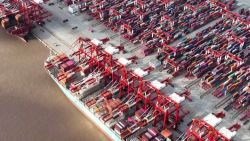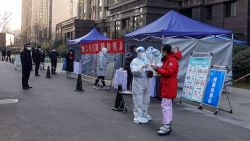China is in the middle of a huge power crunch as extreme weather, surging demand for energy and strict limits on coal usage deliver a triple blow to the nation’s electricity grid. It’s a problem that could last for months, straining the country’s economic recovery and weighing on global trade.
Several Chinese provinces have said they are facing a power crunch in recent weeks, including some of the country’s most important engines for economic growth.
Guangdong province — a manufacturing center responsible for $1.7 trillion, or more than 10%, of China’s annual economic output and a bigger share of its foreign trade — has been rationing power for over a month. The restrictions have forced companies across the province to shut down for a few days per week. Some local authorities are warning that power rationing could last through the end of the year.
It’s not just Guangdong. At least nine provinces have said they are dealing with similar issues, including Yunnan, Guangxi and the manufacturing hub of Zhejiang, forcing regional authorities to announce power curbs across an area of China the size of the United Kingdom, Germany, France and Japan combined.
The power crunch even contributed to a slowdown in factory activity growth in China in June, the country’s National Bureau of Statistics acknowledged on Wednesday.
It’s the worst energy shortage in China since 2011, when droughts and surging coal prices pushed 17 provinces or regions to curb electricity use. Power plants are reluctant to produce a lot of electricity when the coal they burn is expensive: Beijing controls the cost of power, so producers can’t simply raise their prices.
This time around, the post-pandemic commodities boom and severe weather are once again forcing coal power plants to curb output, while also hampering hydroelectricity. But there’s a key difference: China is also grappling with how to meet President Xi Jinping’s push for a carbon neutral China by 2060. That ambitious target for the world’s biggest coal consumer has led the country’s coal mines to produce less, resulting in higher prices, according to Yao Pei, chief strategist for Chinese brokerage firm Soochow Securities.
A one-two punch to the economy
The shortages could deliver a one-two punch that may knock China’s fragile recovery off course, while spelling further trouble for global supply chains that are already struggling to cope.
“The power rationing will inevitably hurt the economy,” said Yan Qin, lead carbon analyst for Refinitiv.
A shortage of electricity could reduce output across virtually every sector of the economy, including key construction and manufacturing industries. Such businesses used nearly 70% of China’s electricity last year, according to the National Bureau of Statistics, and have been major drivers of the recovery in 2021.
Guangdong-based Chengde New Material, one of the country’s largest stainless steel producers, told clients late last month that it would shut operations for two days per week until power no longer needs to be rationed. The company expects production volumes to decline by 20%, or as much as 10,000 tons of steel per month.
“The companies are not happy about this,” said Klaus Zenkel, chair of the European Union Chamber of Commerce in South China. He said as many as 80 of the chamber’s member companies might have been affected by the government’s orders to suspend operations for a few days a week, adding that domestic manufacturers have been forced to stagger production, too. Some companies have even started renting expensive diesel generators to keep business going, he said.
The power rationing in key metal producing province Yunnan has even caused a decline in the supply of some types of metals, including aluminum and tin, according to government data and independent research.
The production cuts and prospect of missed delivery deadlines across China also risks stretching an already tight global supply chain. Guangdong alone is a manufacturing heartland that accounts for a quarter of China’s total trade, including clothes, toys and electronics.
“It [the power shortage] might add to the shipping delays which can be felt around the globe,” said Henning Gloystein, director of energy, climate and resources at Eurasia Group.
Adding to the pressure is that Guangdong has already seen its incredibly busy container ports clogged by a Covid outbreak. The shipping backlog could take months to clear and lead to shortages during the year-end holiday shopping season. That leaves little room for any additional problems, such as the power shortages.
“The power shortage may lead to work schedule rearrangement for local manufacturers, challenging the timeliness of delivery [and] therefore the rest of the supply chains,” said Lara Dong, senior director for power and renewables in Greater China at IHS Markit.
High demand and extreme weather
Experts attribute the scale of the power crunch to a host of issues, from high demand for energy to extreme weather.
Beijing’s infrastructure-led economic recovery plan is very carbon intensive, according to Lauri Myllyvirta, lead analyst for the Centre for Research on Energy and Clean Air. Through the first five months of the year, power consumption in South China exceeded pre-pandemic levels — up 21% from the same period in 2019, according to the China Southern Power Grid, a big state-owned grid operator.
Coal is still involved in generating some 60% of the country’s power. But the government is wary of that figure rising any higher — and so has been trying to reduce coal consumption as it tries to achieve its goal of becoming carbon neutral by 2060.
Limitations on coal usage, though, have coincided with a thirst for energy caused by economic rejuvenation, along with extreme weather. That’s causing a growing tension between demand and supply.
Exceptionally hot weather in some areas has led to an increase in power demand, as people use more air conditioning and refrigeration.
Meanwhile, there’s a huge strain on energy production. Renewable energy sources, such as hydropower, have been hobbled by drought. Major hydropower hub Yunnan province, for example, has had trouble retaining the water it needs in its reservoirs, according to Myllyvirta.
A nationwide safety check before the Communist Party’s 100th anniversary on Thursday has led to massive suspensions of coal mines across China, exacerbating the strains on the coal supply.
The check comes after a jump in deadly coal incidents recently, in some cases due to illicit mining activity. To “create a harmonious environment” before the anniversary, many coal mines have been ordered to shut for inspections, according to local governments or state firms.
“Political stability is the top priority now until end of July,” Qin said.
China has also struggled to shore up overseas supply. Coal is really expensive to import, according to Eurasia Group’s Gloystein, who said that prices have more than doubled in the last year.
Gloystein also pointed out that trade tensions with Australia — which in 2019 was responsible for nearly 60% of China’s thermal coal imports — have created a strain. Beijing imposed trade barriers against Australian coal last year after Canberra called for an independent investigation into the origins of Covid-19.
Since then, China has imported more coal from Indonesia and South Africa to make up for the deficit, but that hasn’t filled the gap.
“This has left some Chinese utilities short of fuel for their power stations,” Gloystein said, adding that it’s tough to get extra supply on short notice from places like Indonesia.
Shortages could continue
Power shortages are likely to continue for at least the next few months, especially as demand stays high in the hot summer months. Qin from Refinitiv said that there are “still significant risks” that southern and central China will need to continue rationing power, especially if the weather is hotter than normal.
The government has other options, too. Gloystein suggested that China could remove barriers against Australian coal, although “that would make Beijing look rather weak.”
And ultimately, authorities may have to think about giving way on some climate targets. He suggested that Beijing could “throw back online” power plants that were shut down earlier this year to curb excess pollution.
Qin said that power shortages are likely to remain a problem “quite often” for at least a while, though. China seems committed to controlling dirty energy, and is trying to up its use of renewable sources and reduce the use of fossil fuels.
“The issue facing China’s power supply is how to both meet rising electrification needs and decarbonization goal,” Qin said, adding that while China is developing a lot of renewable energy sources, those sources aren’t yet as stable as ones that use fossil fuels.

























